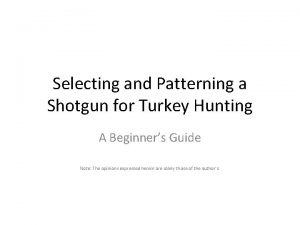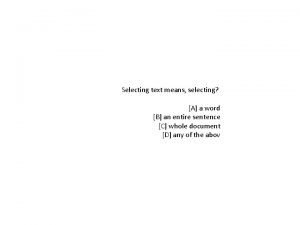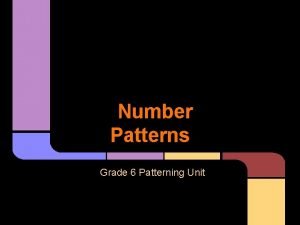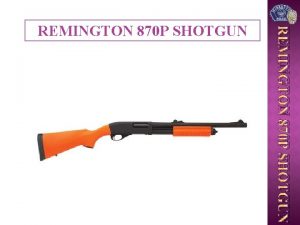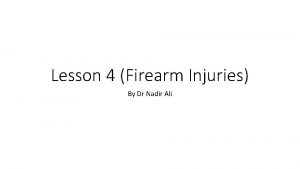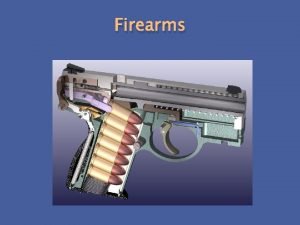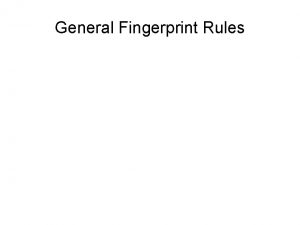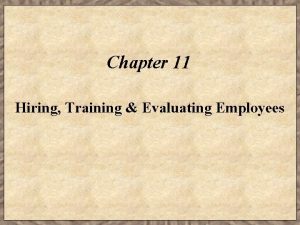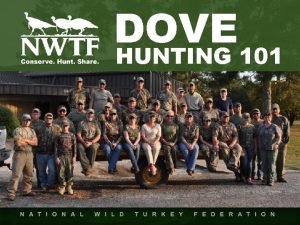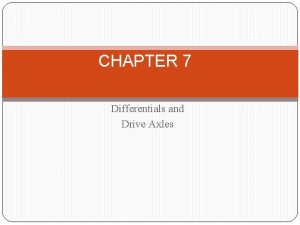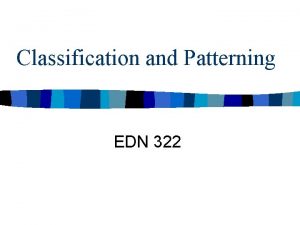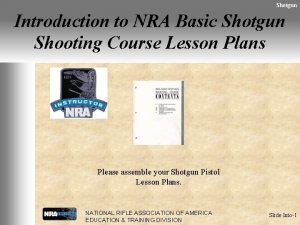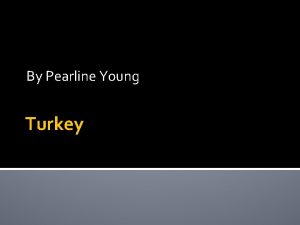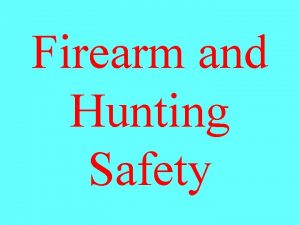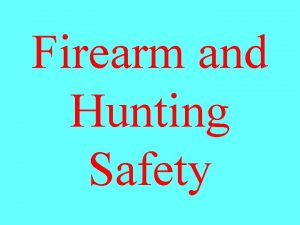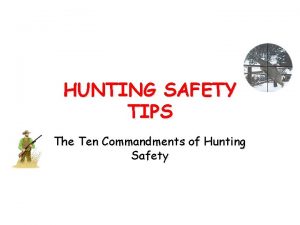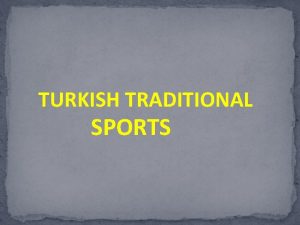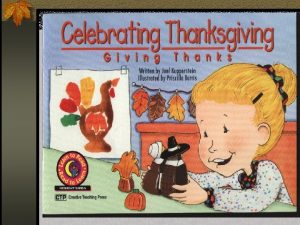Selecting and Patterning a Shotgun for Turkey Hunting






































- Slides: 38

Selecting and Patterning a Shotgun for Turkey Hunting A Beginner’s Guide Note: The opinions expressed herein are solely those of the author’s.

Your mission as a responsible turkey hunter is clear: • Know the absolute range (in yards) at which YOUR PERSONAL shotgun can consistently: – Put 6 or more pellets in the turkey’s vertebrae (spine) and brain… – And/or put 100 or more pellets in a 10” circle. • This will ensure a quick, humane kill.

Why pattern your shotgun? • Establishing a gun’s maximum effective range is critical because: – Ethical hunters know their limits. – Ethical hunters avoid needlessly crippling birds. • Other benefits of patterning: – Gain confidence in your skills. – Range practice helps eliminates mistakes in the field.

Why are spine/head shots important? • A shot to the bird’s nervous system drops him in his tracks (he’ll flop, but won’t go anywhere). • A turkey’s wing feathers are tough and thick. – Pellets will bounce off at farther distances! • A turkey’s vital organs (heart and lungs) are deep inside the bird, making them hard to penetrate. • Wounded birds don’t leave a blood trail, making them hard or impossible to recover. • Less damage to the tasty breast meat!

Key shotgun patterning variables • • The shotgun choke. Shot size, pellet count and pellet energy. Turkey-specific shotgun sites (front and rear sites or scope).

Shotguns for turkey hunting: • You don’t need a fancy gun to kill turkeys! • A 12 or 20 gauge shotgun with a plain, unfinished wood or black synthetic stock works just fine. • Guns with a “Parkerized” finish are best. – This is a non-glare (not “blued”) finish that also withstands field abuse. – Use camo tape or a “gun sock” to minimize glare from stocks and barrels.

Shotguns for turkey hunting: • You don’t need a special turkey barrel, pistolgrip stock or permanent camo. – Not that those are bad, but they’re not critical. • A standard 26” or 28” barrel (21” for a youth gun) works great. – Guns that fire a 3” length shell give you more flexibility than 2 -3/4” only guns. • For best results, use a shotgun with a “screwin” choke design.

Some popular pump shotguns costing less than $450: • Remington 870 Express (3”) or 870 Express Magnum (3. 5”) – Available in 20 ga. youth models • Mossberg 500 • Benelli Nova – Available in 20 ga. youth models • Charles Daly Field Grade – Available in 20 ga. youth models • Stoeger Industries P-350 – Also makes an affordable semi-automatic shotgun • H&R (Harrington & Richardson; includes guns from New England Firearms) – Available in 20 ga. youth models – Also sells very affordable single-shot guns – Takes chokes compatible with “Browning/Winchester/Mossberg”

Popular shotguns-2: • The author personally believes that one shotgun can be use for almost every type of game bird: – For about a decade, he used a Remington 870 Express Magnum (26” barrel, black synthetic stock) for turkey, geese, pheasants and the occasional duck, grouse and rabbit. – Good fortune recently enabled adding an auto-loading shotgun that holds shells up to to 3 -1/2”, which also gets used for all game, plus sporting clays. – The author also added a 20 gauge 870 Express youth gun specifically for loaning to beginning hunters.

Screw-in chokes: you want one! • A shotgun choke constricts, or narrows, the bore of a shotgun to a specific diameter. • Chokes adjust the shot pattern so that it is wider or narrower at a given distance. – By just changing chokes and ammunition, you can get optimum performance from one gun for many different types of game.

Screw-in chokes-2 • Chokes specifically designed for turkey hunting provide tighter patterns than factory “full” chokes. • A turkey choke for a 12 gauge constricts the bore to a diameter of. 660 -. 680”. – A 20 gauge turkey choke has a diameter of. 570 -. 582”. • Turkey chokes cost $20 to $100. • More expensive is not necessarily better.

Popular aftermarket turkey chokes: • • • H. S. (Hunter’s Specialties) “Undertaker” Primos Jelly Head Kicks Industries Carlson’s Rhino Chokes M. A. D. Calls chokes (now owned by Flambeau Outdoors) Comp-N-Choke Patternmaster Black Cloud Truglo Pure Gold Hastings

EVERY shotgun has a personality • Two guns from the same manufacturer can shoot completely differently with the exact same choke and brand of shell! • This is why patterning YOUR GUN with YOUR CHOKE TUBE and YOUR AMMUNITION is an absolutely essential part of becoming an ethical turkey hunter!

Turkey ammunition-1 • What’s the right ammunition? – It’s the shot shell that produces the best pattern in your gun, and… – Producers a recoil level that you can manage, and… – Retains sufficient downrange energy for a clean kill, and… – Fits your budget.

Turkey ammunition-2 • Generally, use shot size #5 or #6. – Larger size shot has more energy per pellet, but fewer pellets per shell. – Smaller shot provides more pellets per shell, but less energy per pellet. – If you can keep shots to 15 -20 yards or less, it’s OK to use #7 shot • Be aware of state regulations – in Wisconsin, #4 lead/lead substitute or #2 steel is the largest shot size permissible.

Turkey ammunition-3 • Lead pellet size and pellet count: – Size 4: 135 pellets per oz. – Size 5: 170 pellets per oz. – Size 6: 225 pellets per oz • • • HEVI-SHOT® Size and Pellet Count 7342 6237 5180 4107 277

Turkey ammunition-4 • Use shells designed for turkey hunting; they have more pellets and pattern better. • You do not necessarily need the most powerful turkey load. – In fact, one of my guns patterns better with a lower velocity 1 -7/8 oz. load than with a high-speed 2 -1/4 oz. load! – Lower-powered loads have less recoil and may be better suited for youth and small frame hunters.

Turkey ammunition-5 • About copper- or nickel-plated lead shot: it penetrates better than plain lead. – If you’re keeping shots to 30 yards or less, start with #6 shot. – If you’re shooting a magnum load at longer distances, go with #5. – If you’re shooting a modified or factory full choke at less than 20 yards, go with #7. • Remington, Federal, Winchester, Fiocchi, Kent and other major brands all work well.

Turkey ammunition-6 • Consider high-density (“HD”) or other “heavier -than-lead” alternatives. – HD turkey loads tend to pattern well. – According to Federal, its #7 HD shot retains the same downrange energy as #5 lead shot out to 40 yards. • You’ll get more pellets per shell with #6 or #7 shot, creating a denser and more lethal shot pattern. – HD ammo costs more, but it’s really worth it for 20 gauge guns or lighter 12 gauge loads. • Really consider #7 HD if you’re shooting a low-power load.

Turkey ammunition-7 • Popular HD and heavier-than-lead ammunition is available from Remington, Winchester, Federal, Hevi-Shot and Nitro Company Ammunition.

Sights for turkey hunting • The typical factory shotgun sight is a metal bead or small fiber optic dot. • These sights are designed for “wing shooting” birds on the move. • With turkeys, you need to AIM your shotgun at a SPECIFIC spot (the turkey’s head/neck).

Turkey sights-2 • To consistently hit a specific target, two reference points are much better than one. • For turkey hunting, fiber optic “open sights” – a front bead and a rear “V” sight – increase shooting accuracy. • At a minimum, use rear sights that allow you to make “windage” adjustments. – Who wants the confusion of remembering to hold 6” to the left or right when you’re gripped with “gobbler fever? ”

Turkey sights-3 • If your shotgun shoots more than 6” high or low, consider a sight with elevation adjustments (up/down). • Note that it is easier to hold a few inches high/low vs. “guesstimating” air space to the left or right of a bird, as you can pick a consistent aiming point on the bird’s body.

Popular fiber optic turkey sights • Truglo - probably the best known brand with the most options • Hi. Viz – quality products • Williams – quality products

Scopes for turkey hunting-1 • Scopes might not be best for beginners: – Hard to make a quick shot. – Scopes can fog up if you breathe on them. – The possibility of a “scope eye” cut exists, and that’s a negative experience for a young hunter. – They cost about $150+ for the scope, base and rings. – Easier to damage that basic sights.

Benefits of scopes • Scopes do allow for precise windage and elevation adjustments. • A 1. 75 – 4 X scope may provide a clearer sight picture, especially when the foliage gets denser later in the season. • “Red Dot” scopes are also an option. – They’re lighter than regular scopes, but they also require batteries.

Benefits of scopes-2 • Scopes for turkey hunting MUST have at least 4” of eye relief (and 6” is better) or you WILL get scope eye. Popular and affordable choices include: – Bushnell Banner 1. 5 x 4 x 32 mm – Tru. Glo (scopes and red dot options) – Aimpoint (premium red dot scopes)

Shotgun patterning steps • • Install the sight of your choice at home, but be sure to bring tools to the range if you need to make adjustments. Install the screw-in choke at home, but again bring your choke tools to the range. Consider testing several different types of turkey ammunition (brand, shot size, shot type). Team up with a couple of friends to share the cost. Bring a box of ordinary target or small game loads. – Turkey loads create a lot of recoil. The game loads will help you “get on paper” and save your shoulder.

Shotgun patterning steps-2 • To tame the recoil and prevent flinching, wear a thick jacket. – – Even better, use a special recoil absorbing pads, such as those from PAST, Limbsaver. Or go with a “lead sled. ” Or, use a low-powered load, pattern you gun and know your maximum range. Whatever you do, you don’t want to flinch. • To ensure a steady shot, shoot off a bench or use crossed “steady sticks. ” – Make your own crossed sticks with two dowel rods, a bolt/wing nut and camo tape. Cost: less than $5.

Shotgun patterning steps-3 • Bring at least 10 turkey targets that show the bird’s brain and spine. – Remember to aim at the base of the head/neck. • Bring a pen to write down ammo/distance details on each target.

Shotgun patterning steps-4 • Take a shot or two at 10 yards using the small game loads. This should show you if you’re hitting hi-lo/L-R. • Make any major sight adjustments at short range with the low power loads. – Note that these loads will probably hit lower than your high-powered turkey loads. • Take your first shot with your turkey load at 10 yards – close shots happen! – Consider making sight adjustments if obviously needed.

Shotgun patterning steps-5 • Move back to 20 yards, shoot, analyze the pattern and adjust sights as needed. – Consider quickly cleaning the barrel between shots (1 or 2 wet patches followed by 2 dry patches) to maintain consistency. • Try to get a good pattern out to 20 yards. – If you don’t get one, consider a different size shot or brand of ammo.

Shotgun patterning steps-6 • If you have a solid pattern at 20 yards, move back to 30 yards and repeat the process. • If you have a solid pattern at 30 yards, move back to 40 yards. – If the pattern is getting spotty (but still a “kill”), only move out to 35 yards.

Shotgun patterning steps-7 • If you have a good pattern at 40 yards, stop. Don’t shoot beyond 40 yards. – 3 -1/2 shells MIGHT be good out to 50 yards with the right choke. • Turkeys are big birds, so many people think the birds are closer than they actually are. – – You may think the bird is 30 yards away, but it’s probably closer to 40. Pace off your maximum effective range when hunting; jam a stick in the ground or use a good landmark, like a bush or tree.

Summary • You can kill a turkey with any shotgun, IF you know its maximum effective range. • Consider investing in (or borrow) a shotgun, choke, ammunition and sights designed for turkey hunting. • No matter shotgun you use, you MUST pattern it prior to hunting. – You will be able to CONFIDENTLY take a shot at a maximum known distance.

Summary-2 • Turkey hunting without patterning your shotgun is irresponsible, unethical and leads to needlessly wounded birds!

Gun Safety Above All Else Remember TAB-K: • Treat every gun as if it were loaded. • Always point your gun muzzle in a safe direction. • Be sure of your target and what’s beyond. • Keep your finger out of the trigger guard until you’re ready to shoot.

And Hunting Safety, too! • Never shoot at sounds, movements or patches of color. • Only shoot after you have identified your intended target with 100% certainty. – In the spring, this means NEVER shooting until you can positively identify the tom’s beard. • Only shoot if you have a clean shot (not obstructed by brush) at the animal’s vitals: – On a turkey, you only have 1 possible shot: the head/neck area.
 Why do hunters pattern their shotguns
Why do hunters pattern their shotguns Okc crips
Okc crips Selecting text means
Selecting text means Antithesis parallelism
Antithesis parallelism Left right patterning
Left right patterning Sentence patterning chart
Sentence patterning chart Martha rogers' theory application
Martha rogers' theory application Pattern grade 6
Pattern grade 6 The power i offense
The power i offense Remington 870 p
Remington 870 p Ricochet phenomenon
Ricochet phenomenon Pyrosequencing animation
Pyrosequencing animation Hierarchical shotgun sequencing vs whole genome
Hierarchical shotgun sequencing vs whole genome Hierarchical shotgun sequencing vs whole genome
Hierarchical shotgun sequencing vs whole genome Egun railgun shotgun
Egun railgun shotgun Barrel markings
Barrel markings Blooming grove hunting and fishing club website
Blooming grove hunting and fishing club website Fly fishing guide salary
Fly fishing guide salary Why do we have hunting laws and regulations
Why do we have hunting laws and regulations Screen with siege of belgrade and hunting scene
Screen with siege of belgrade and hunting scene Migratory bird hunting and conservation stamp act
Migratory bird hunting and conservation stamp act Indirect cost of expatriate failure
Indirect cost of expatriate failure Rules in locating the core
Rules in locating the core Identifying and selecting systems development projects
Identifying and selecting systems development projects Chapter 18 eggs selecting and storing eggs
Chapter 18 eggs selecting and storing eggs Strategies for acquiring it applications
Strategies for acquiring it applications Potential market
Potential market Recruiting and selecting sales personnel
Recruiting and selecting sales personnel Selecting organizing and interpreting information
Selecting organizing and interpreting information What three brainstorming methods can you follow
What three brainstorming methods can you follow Hiring training and evaluating employees
Hiring training and evaluating employees Chapter 5 selecting a topic and a purpose
Chapter 5 selecting a topic and a purpose Chapter 5 selecting a topic and a purpose
Chapter 5 selecting a topic and a purpose Compare and contrast israel saudi arabia and turkey
Compare and contrast israel saudi arabia and turkey Acrostic poem for ocean
Acrostic poem for ocean Rooibok vitals
Rooibok vitals Dove hunting 101
Dove hunting 101 Pengertian jaringan publik
Pengertian jaringan publik Partial non hunting gearset
Partial non hunting gearset
